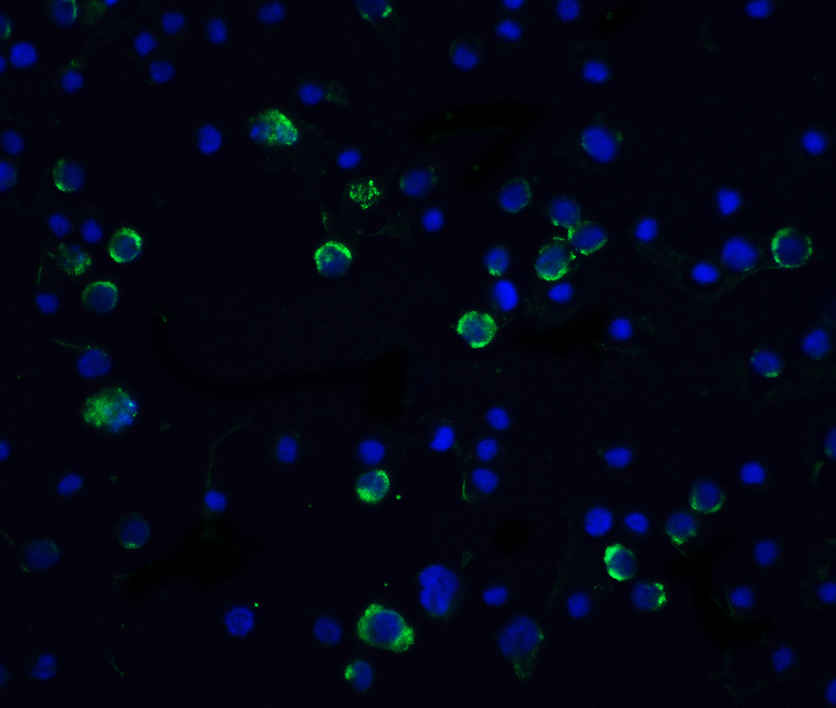NK3R Antibody
- SPECIFICATION
- CITATIONS
- PROTOCOLS
- BACKGROUND

Application
| WB, IHC-P, IF, E |
|---|---|
| Primary Accession | P29371 |
| Other Accession | P29371, 6870 |
| Reactivity | Human, Mouse |
| Host | Rabbit |
| Clonality | Polyclonal |
| Isotype | IgG |
| Calculated MW | Predicted: 51 kDa Observed: 45 kDa |
| Application Notes | NK3R antibody can be used for detection of NK3R by Western blot at 0.5 - 2 μg/mL. Antibody can also be used for immunohistochemistry starting at 5 μg/mL. For immunofluorescence start at 20 μg/mL. |
| Gene ID | 6870 |
|---|---|
| Target/Specificity | NK3R antibody was raised against a 18 amino acid synthetic peptide from near the center of human NK3R. The immunogen is located within amino acids 370 - 420 of NK3R. |
| Reconstitution & Storage | Antibody can be stored at 4°C up to one year. Antibodies should not be exposed to prolonged high temperatures. |
| Precautions | NK3R Antibody is for research use only and not for use in diagnostic or therapeutic procedures. |
| Name | TACR3 |
|---|---|
| Synonyms | NK3R, TAC3R |
| Function | This is a receptor for the tachykinin neuropeptide neuromedin-K (neurokinin B). It is associated with G proteins that activate a phosphatidylinositol-calcium second messenger system. The rank order of affinity of this receptor to tachykinins is: neuromedin-K > substance K > substance P. |
| Cellular Location | Cell membrane; Multi-pass membrane protein. |

Thousands of laboratories across the world have published research that depended on the performance of antibodies from Abcepta to advance their research. Check out links to articles that cite our products in major peer-reviewed journals, organized by research category.
info@abcepta.com, and receive a free "I Love Antibodies" mug.
Provided below are standard protocols that you may find useful for product applications.
Background
NK3R Antibody: The tachykinins are a family of small peptides that include the neurotransmitters substance P, neurokinin A, and neurokinin B, which can act on three related but distinct seven transmembrane G-proteins coupled receptors, albeit at different concentrations. The NK-3 receptor (NK3R) has greatest affinity for neurokinin B and is highly expressed in the supraoptic and paraventricular nuclei. Following binding of its ligand, NK3R activates a phosphatidylinositol-calcium second messenger system. It is likely these signals lead to the release of vasopressin and oxytocin into the circulation. NK3R may be involved in learning and memory as mice lacking this gene expressed cognitive deficits compared to normal mice. Although it has been suggested that NK3R plays a role in the regulation of vagal afferent relay neurons, it is likely that these receptors are activated by substance P or neurokinin A, as the airway nerves do not express neurokinin B.
References
Maggi CA. The mammalian tachykinin receptors. Gen. Pharmacol. 1995; 26:911-44.
Ding Y-Q, Shi J, Su L-Y, et al. Receptor (NK3)-containing neurons in the paraventricular and supraoptic nuclei of the rat hypothalamus synthesize vasopressin and express fos following intravenous injection of hypotonic saline. Neurosci. 1999; 91:1077-85.
Nakajima Y, Tsuchida K, Negishi M, et al. Direct linkage of three tachykinin receptors to stimulation of both phosphatidylinositol hydrolysis and cyclic AMP cascades in transfected Chinese hamster ovary cells. J. Biol. Chem. 1992; 267:2437-42.
Haley GE and Flynn FW. Tachykinin NK3 receptor contribution to systemic release of vasopressin and oxytocin in response to osmotic and hypotensive challenge. Am. J. Regul. Integr. Comp. Physiol. 2007; 293:R931-7.
If you have used an Abcepta product and would like to share how it has performed, please click on the "Submit Review" button and provide the requested information. Our staff will examine and post your review and contact you if needed.
If you have any additional inquiries please email technical services at tech@abcepta.com.













 Foundational characteristics of cancer include proliferation, angiogenesis, migration, evasion of apoptosis, and cellular immortality. Find key markers for these cellular processes and antibodies to detect them.
Foundational characteristics of cancer include proliferation, angiogenesis, migration, evasion of apoptosis, and cellular immortality. Find key markers for these cellular processes and antibodies to detect them. The SUMOplot™ Analysis Program predicts and scores sumoylation sites in your protein. SUMOylation is a post-translational modification involved in various cellular processes, such as nuclear-cytosolic transport, transcriptional regulation, apoptosis, protein stability, response to stress, and progression through the cell cycle.
The SUMOplot™ Analysis Program predicts and scores sumoylation sites in your protein. SUMOylation is a post-translational modification involved in various cellular processes, such as nuclear-cytosolic transport, transcriptional regulation, apoptosis, protein stability, response to stress, and progression through the cell cycle. The Autophagy Receptor Motif Plotter predicts and scores autophagy receptor binding sites in your protein. Identifying proteins connected to this pathway is critical to understanding the role of autophagy in physiological as well as pathological processes such as development, differentiation, neurodegenerative diseases, stress, infection, and cancer.
The Autophagy Receptor Motif Plotter predicts and scores autophagy receptor binding sites in your protein. Identifying proteins connected to this pathway is critical to understanding the role of autophagy in physiological as well as pathological processes such as development, differentiation, neurodegenerative diseases, stress, infection, and cancer.


